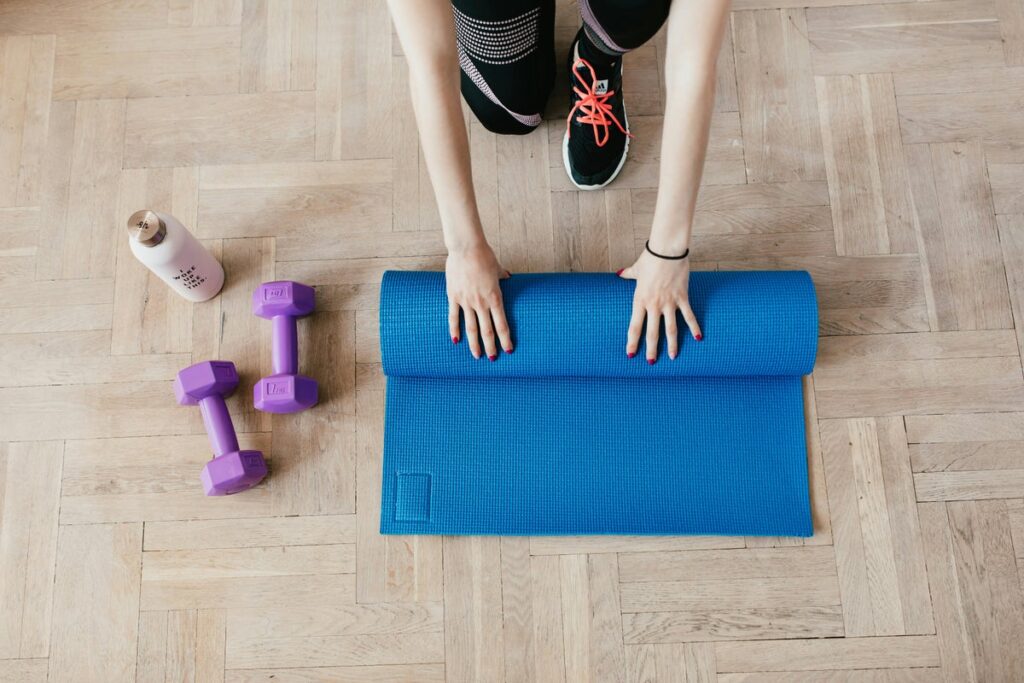Chances are, you’re incredibly busy. Most people are always on their smartphones, providing an ever-present tether to work. Add this to all your other commitments and it’s no wonder fitness is falling down the pecking order.
As a result, the blanket prescriptions of 10,000 steps a day, eight hours of sleep each night, home-cooked meals where possible and hour-long gym sessions read like a pipe dream for most. So, how much time and effort do you really need to commit if you want to maintain a fit and functional body for decades to come?
According to experts, it could be less than you think. More is generally better (sleep, exercise, daily steps etc.), but most people can achieve impressive results by adopting just a few sustainable healthy behaviours.
Walking
Walking 10,000 steps a day is seen as a holy grail of health by some. And while moving this much is going to do your health plenty of favours, the number itself has “no scientific basis”, according to a 2023 study led by the University of Granada.
This research instead concludes that 8,000 is “the optimal number of (daily) steps at which most people obtain the greatest benefits”, and “the pace at which you walk provides additional benefits” – walking faster can deliver more health perks.
Further research, published in the European Journal of Preventive Cardiology, identified “a significant inverse association between daily step count and all-cause mortality… with the more the better over the cut-off point of 3,867 steps per day for all-cause mortality and only 2,337 steps for cardiovascular mortality (death related to diseases of the heart or blood vessels)”. These totals are some way short of 10,000 steps per day, but still have plenty to offer.
The research also showed that “a 1,000-step increment (or increase in your number of daily steps) correlated with a significant reduction of all-cause mortality of 15 per cent, and similarly, a 500-step increment correlated with a reduced risk of cardiovascular mortality of 7 per cent”.
This suggests that even a small increase in the amount you move each day can have significant health benefits. Rather than aiming for 10,000 steps per day, try looking at your average daily step count on your phone and then increasing this by 10 per cent, slowly building over time towards the 8,000 steps per day sweet spot.
Actionable takeaways:
Read more: Why you get headaches when you exercise, despite drinking water

open image in gallery
Strength training
According to Dr Richard Blagrove, a senior lecturer in physiology at Loughborough University, strength training offers more bang for your buck than any other exercise modality. If you want to make a difference to your health and have limited time to exercise, this should be your priority.
“The evidence suggests that lifting weights regularly (a couple of times per week) has the most benefits because it improves body composition, muscle mass, cognitive function, metabolic processes, mobility and glucose homeostasis, which is linked to risk of type two diabetes,” Dr Blagrove says.
“The only parameter of fitness it tends not to change is cardiorespiratory function, which aerobic-based exercise is needed for.”
He adds that strength and muscle size can be “maintained on one resistance training session per week, and one set per exercise, if intensity of exercise is high for up to 32 weeks”.
These sessions don’t have to be particularly long either, but intensity needs to be high for maximum results. In practice, this means you should be performing a strength training exercise – like a press-up or squat – with good form until your muscles fatigue to the point that you are involuntarily forced to slow down.

open image in gallery
But if you only have 10-20 minutes to exercise, twice per week, what strength training workout should you choose?
Esteemed strength coach Dan John works on the foundational principle that “the body is one piece”, and prescribes full-body workouts as a time-savvy way to train. This way, each major muscle group will still be worked fairly frequently.
John adds that you can start with just three exercises – the kettlebell swing, goblet squat and press-up – which can easily be done at home with just one kettlebell.
“To me, 75 swings, 15 goblet squats and 15 press-ups per session circles that perfect volume load for a new person who’s in some kind of shape,” he tells me. “The humane burpee is the best single-kettlebell workout. You do 15 swings, five goblet squats and five push-ups, then 15 swings, four goblet squats and four push-ups, and so on until you reach zero.
“You get sweaty. You’re getting stronger. You’re going to become a little more mobile. Every quality you want to chase is going to be in there somehow.”
Actionable takeaways:
Read more: Protein is being added to yoghurt, bread and coffee. We might have gone too far

open image in gallery
Cardiovascular exercise
According to Dr Blagrove, cardiorespiratory function is one of the only factors that lifting weights is unlikely to have much impact on. For this reason, some form of cardiovascular exercise each week is recommended.
This can be walking, or something faster-paced like running, cycling or swimming if you have the capacity. And again, especially for someone who lives a fairly sedentary lifestyle, sessions don’t have to be particularly long to have an impact.
Most evidence points towards two sessions per week, each lasting roughly 13-26 minutes, which can maintain fitness in trained individuals for four months if intensity is appropriate, Dr Blagrove says. Logic dictates that the benefits of this for untrained individuals (those who don’t regularly exercise) are likely to be far greater.
Actionable takeaways:
Read more: The three ‘essential’ kettlebell exercises for health and longevity, according to an expert strength coach

open image in gallery
Sleep
But while a chorus of 6am alarms stops many from improving their sleep quantity, there are a few sleep tricks you can use to improve your sleep quality, with purported benefits including better appetite regulation, improvements in heart disease risk factors and a welcome boost for your immune system.
These tips, from The Sleep Scientist founder Dr Sophie Bostock, are listed below.
Actionable takeaways:
Read more: These are the 13 best men’s gym trainers you can buy, according to our expert tester

open image in gallery
Diet
Adopting achievable healthy habits can be a more sustainable way to achieve long-term health.
“The majority of diets fail long term,” says Fat Loss Habits author Ben Carpenter. “Most people who go on a diet will stop following that diet within six to nine months. That’s very well backed up by research. The majority of people who lose weight will regain a lot of that weight over the course of the first few months or years.”
For this reason, he recommends swapping restrictive diets for a selection of sustainable habits to give yourself the best chance at long-term health and successful weight management.
These habits, listed below, are individualised – some will work for you, some won’t. The idea is to find those that do and stick with them, because any positive behavioural change performed consistently over time is bound to have an impact. However, of all the habits Carpenter suggests, one rules supreme.
“Focus on adding in nutritious foods because they have a habit of displacing other foods out of your diet,” he says. Appetite is finite, so by eating more nutritious foods, you are likely to consume fewer less nutritious, calorie-dense offerings. This can reduce your daily calorie intake without the need for a strict diet, tracking or calorie counting.
“When I say focus on more nutritious foods, these are often foods which tend to be slightly less processed,” Carpenter adds. “For example, fruits and vegetables, lean proteins (white fish, white meat, soy, tofu), beans, lentils and wholegrains. Even things like rice and oats as opposed to doughnuts, pancakes and waffles.”
Actionable takeaways:
Read more: You need much more protein than you think and here’s how to get it

open image in gallery
Summary
But when considering the “minimum effective dose” – the minimum amount of work you need to do to achieve a certain outcome – for getting and staying in shape, Dr Blagrove says to be aware the term is somewhat outdated.
Why? Because the latest research suggests that “even doing very small amounts of exercise or physical activity is beneficial for health, but more is better for us”.
“For example, even burning 500 kcal per week shows reductions in risk of mortality compared to being completely inactive (as shown in a study from the British Journal of Sports Medicine),” he says.

open image in gallery
For this reason, his foundational message is to find a sport, exercise or physical activity you enjoy, then stick with it.
“Doing a small amount of something active most days, long term, is better than trying to do excessive amounts short term then quitting because it feels like a chore or is too difficult to achieve,” he adds.
The same applies to sleep and diet. Aim for positive long-term behaviours, rather than unsustainable changes in the short term, to see consistent results.
As Carpenter says: “Being consistently good for 12 months will be a lot better for your health than being perfect for one month, then stopping because you can’t maintain that level of perfection.”
Read more: A fat loss expert says ‘diets don’t work’ – he recommends doing these five things instead for long-term results



